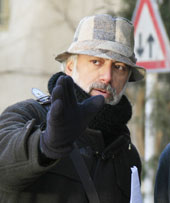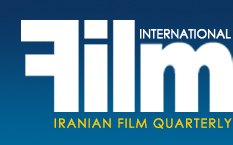|
Interview with Shahrokh Dolkou, director of video clips and advertisements
Toward Globalization
|
 Making video clips is still nascent in Iran, but it has been through many ups and downs during that short period. Shahrokh Dolkou directed the first video clip of the Iranian television in 1994. It was called “Brother Is Restless” and was based on a song which was sung by the master of the Iranian music, Mohammad Reza Shajarian; it was given a warm welcome by the audience. His second clip was The Return, which became a favorite among the youth because of its rapid tempo, special visual effects and Eric Clapton’s music. Dolkou has also made other clips for the Iranian television most of which have been among the best televised clips and have been watched by large audience. They include Horizon, Vampire, Story of Flight, Madness, and Shadow as well as biographical clips depicting s number of the most renowned Iranian actors and actresses including Ezzatollah Entezami, Jamshid Mashayekhi, Jaleh Olov, and Nikou Kheradmand. Dolkou has been also working as director of advertisements for many years and has made ads for famous brands including Samsung, LG, Hacoupian, Iran Khodro, Saipa, Bank Maskan, and Sairan which have been favorites of television audience. Dolkou holds a bachelor’s degree in cinema, editing major, as well as a master’s in dramatic literature. He has been working with many magazines as film critic for many years. As screenwriter, he has a number of screenplays on his track record including Leila’s Sleep which has been dramatized as a feature film. He has been also member of jury for video clips and ads in various festivals and has had his first experienced in directing by making The Return. In the following interview he talks about video clips and advertisements in Iran. Making video clips is still nascent in Iran, but it has been through many ups and downs during that short period. Shahrokh Dolkou directed the first video clip of the Iranian television in 1994. It was called “Brother Is Restless” and was based on a song which was sung by the master of the Iranian music, Mohammad Reza Shajarian; it was given a warm welcome by the audience. His second clip was The Return, which became a favorite among the youth because of its rapid tempo, special visual effects and Eric Clapton’s music. Dolkou has also made other clips for the Iranian television most of which have been among the best televised clips and have been watched by large audience. They include Horizon, Vampire, Story of Flight, Madness, and Shadow as well as biographical clips depicting s number of the most renowned Iranian actors and actresses including Ezzatollah Entezami, Jamshid Mashayekhi, Jaleh Olov, and Nikou Kheradmand. Dolkou has been also working as director of advertisements for many years and has made ads for famous brands including Samsung, LG, Hacoupian, Iran Khodro, Saipa, Bank Maskan, and Sairan which have been favorites of television audience. Dolkou holds a bachelor’s degree in cinema, editing major, as well as a master’s in dramatic literature. He has been working with many magazines as film critic for many years. As screenwriter, he has a number of screenplays on his track record including Leila’s Sleep which has been dramatized as a feature film. He has been also member of jury for video clips and ads in various festivals and has had his first experienced in directing by making The Return. In the following interview he talks about video clips and advertisements in Iran.
Film International: You have been working as director of video clips and advertisements. Please explain about the relationship between the two.
Shahrokh Dolkou: They are similar both in form and content. As for the form, both of them avail of short time frames. Ads usually take 10-45 seconds and video clips are no longer than 3-7 minutes. The difficulty is for you to convey your message in a correct manner in that short time. On the other hand, both of them are based on short scenes, rapid tempo, fantastic set design and special visual effects. Both are full of diversity in style while imagination plays an important role. As for the content, both items try to convince viewers to buy and consume a commodity. Advertisements promote a commodity (which is not always a commercial one, but may be a book or calling for help to children with cancer or introduction of a website) while video clips usually promote a musical band, a singer, or a special song. Anyway, both of them take advantage of diverse, dynamic, attractive and fantastic frames.
FI: Unlike ads, video clip is new in Iran. How it started in the country?
SD: In 993, I teamed up with a number of my friends, the most famous of whom was the film actor, Reza Kianian, to establish a company we called Arts Development Workshop. We were a bunch of energetic youth full of new ideas trying to introduce new visual products. One of those products was video clip, which had enjoyed a special position in visual arts in other countries (especially the United States) for years, but was unknown in Iran. We proposed the project to the state-run television and spent a lot of energy to get them invest in it. I directed the first official clip which was received warmly by television audience (because it presented a new form). Thus, TV officials were convinced to invest more in this new medium and signed a contract for few more clips with us. The Return signified our attempt to present a more novel form to attract the youth. It was a hit and holds a record for televised broadcast of a video clip. This also happened later to another clip of mine called Madness. I made more than seven clips for Research Department of television some of which won prizes. The Return was the best clip of Soureh Festival, White and Black won the best director’s prize of the third TV Festival and Shadow won prizes for the best clip and the best director in two festivals on AIDS.
SUBSCRIBE
[Page: 60]
|
|
|
|
|
President & Publisher
Massoud Mehrabi
Editors:
Sohrab Soori
Translators:
Sohrab Soori
Behrouz Tourani
Zohreh Khatibi
Saeed Khamoush
Contributors
Shahzad Rahmati
Saeed Ghotbizadeh
Advertisements
Mohammad Mohammadian
Art Director
Babak Kassiri
Ad Designers
Amir Kheirandish
Hossein Kheirandish
Cover Design
Alireza Amakchi
Correspondents
E.Emrani & M. Behraznia (Germany)
Mohammad Haghighat (France)
A. Movahed & M. Amini (Italy)
Robert Richter (Switzerland)
F. Shafaghi (Canada)
B. Pakzad (UAE)
H. Rasti (Japan)
Print Supervisors
Shad-Rang
Noghreh-Abi
Gol-Naghsh
Subscription & Advertising Sales
Address: 10, Sam St., Hafez Ave., TEHRAN, IRAN
Phone: +98 21 66722444
Fax: +98 21 66718871
info@film-magazine.com
Copyright: Film International
© All rights reserved,
2023, Film International
Quarterly Magazine (ISSN 1021-6510)
Editorial Office: 5th Floor, No. 12
Sam St., Hafez Ave., Tehran 11389, Iran
*
All articles represent views of their
authors and not necessarily
those of the editors
|
|
|

